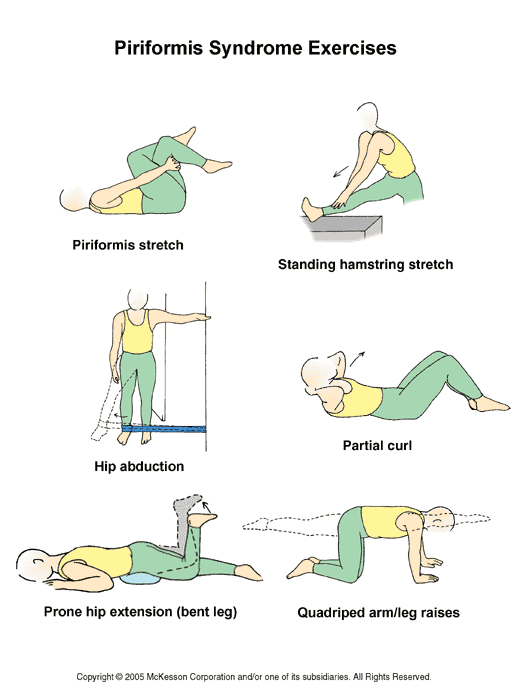What is piriformis
syndrome?
Piriformis syndrome refers to irritation of the
sciatic nerve as it passes through or next to the piriformis
muscle located deep in the buttock. Inflammation of the sciatic
nerve, called sciatica, causes pain in the back of the hip that
can often travel down into the leg.
 How
does it occur?
How
does it occur?
The piriformis muscle is located deep in the
buttock and pelvis and allows you to rotate your thigh outward.
The sciatic nerve travels from your back into your leg by passing
through or next to the piriformis muscle. If the piriformis muscle
is unusually tight or if it goes into spasm, the sciatic nerve can
become inflamed or irritated. Piriformis syndrome may also be
related to intense downhill running.
What are the
symptoms?
You have pain deep in your buttock that may feel
like a burning pain. The pain usually travels down across your
lower thigh. Your pain may increase when you move your thigh
outward, such as when you are sitting cross-legged.
How is it
diagnosed?
Your healthcare provider will talk to you about
when your symptoms began. Since your sciatic nerve begins in the
back, it can be irritated from a back injury, such as a herniated
disk. Your provider will ask if you have had any injuries to your
back or hip. He or she will examine your back to see if the
sciatic nerve is irritated there. He or she will examine your hip
and legs and move them to see if movement causes increased pain.
Your healthcare provider may order X-rays, a
computed tomography (CT) scan, or a magnetic resonance image (MRI)
of your back to see if there is a back injury. There are no X-ray
tests that can detect if the nerve is being irritated at the
piriformis muscle.
How is it treated?
Treatment may include:
- placing ice packs on your buttock for 20 to 30
minutes every 3 to 4 hours for the first 2 to 3 days or until
the pain goes away
- rest
- taking prescribed anti-inflammatory medicines
or muscle relaxants. Adults aged 65 years and older should not
take non-steroidal anti-inflammatory medicine for more than 7
days without their healthcare provider's approval.
- learning and doing stretching exercises of the
piriformis muscle.
How long will the
effects last?
The length of recovery depends on many factors
such as your age, health, and if you have had a previous
piriformis injury. Recovery time also depends on the severity of
the injury. A mild injury may recover within a few weeks, whereas
a severe injury may take 6 weeks or longer to recover. You need to
stop doing the activities that cause pain until your muscle has
healed. If you continue doing activities that cause pain, your
symptoms will return and it will take longer to recover.
When can I return
to my normal activities?
Everyone recovers from an injury at a different
rate. Return to your activities will be determined by how soon
your nerve recovers, not by how many days or weeks it has been
since your injury has occurred. In general, the longer you have
symptoms before you start treatment, the longer it will take to
get better. The goal of rehabilitation is to return you to your
normal activities as soon as is safely possible.
You may safely return to your activities when,
starting from the top of the list and progressing to the end, each
of the following is true:
- You have full range of motion in the affected
leg compared to the unaffected leg.
- You have full strength of the affected leg
compared to the unaffected leg.
- You can walk straight ahead without pain or
limping.
How I prevent
piriformis syndrome?
Piriformis syndrome is best prevented by
stretching the muscles that rotate your thigh inward and outward.
It is important to have a good warm-up before starting your sport
or activity.
 How
does it occur?
How
does it occur? 